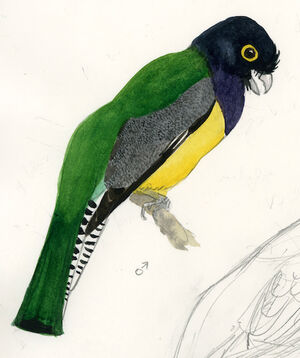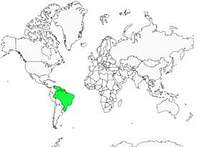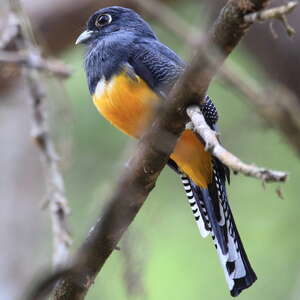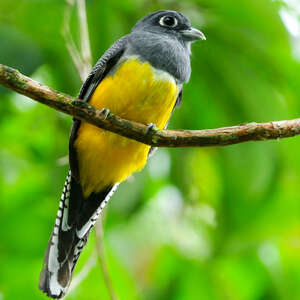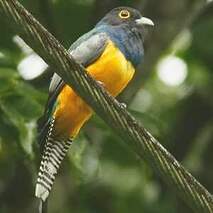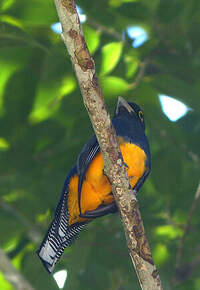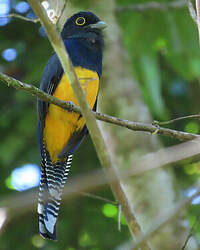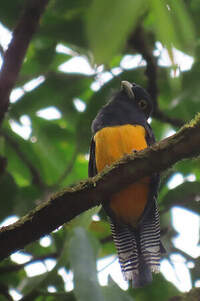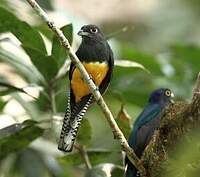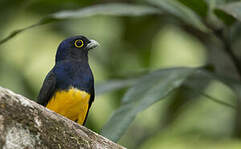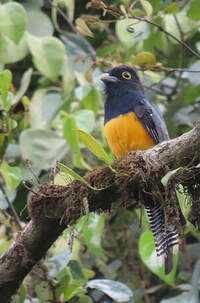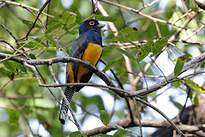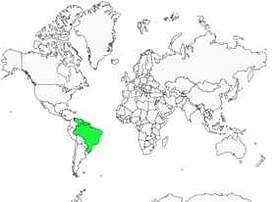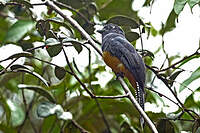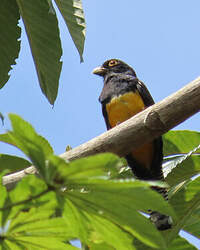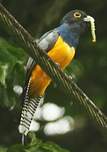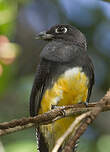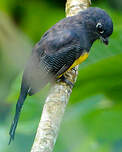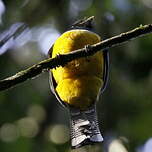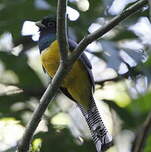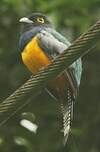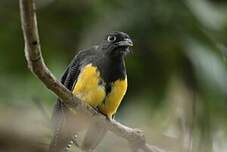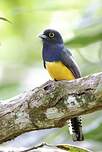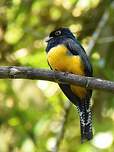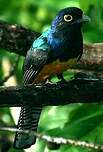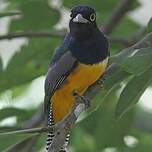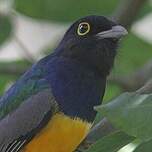Guianan Trogon
Trogon violaceus - Trogon violacé
Identification
The Guianan Trogon, or how to dip a bird in paint pots! Characteristic of all trogons, there is a very marked dimorphism present; the male Guianan Trogon, which gives its name to the species, measures 23 to 25 cm and has a strong gray beak with an upper mandible slightly curved; around the beak, black vibrissae are clearly visible. The throat and parotids are black and, as a unique distinguishing sign, the Guianan Trogon has a yellow orbital circle. The chest, cap and neck are an incredible, iridescent purple-blue in the light. A thin white strip, sometimes absent depending on the individual and subspecies, separates the chest from the brilliant yellow abdomen. The mantle, back, rump and scapulars are brightly painted in a luminous green that contrasts with the anthracite coverts and tertiary remiges; however when one comes up close to the bird, thin white ripple-like lines on these coverts and tertiary remiges can be seen, as though a pointillist painter had stippled these wings in delicate light touches. The black primary remiges are clearly marked in white along the edges. The uppertail coverts are turquoise-blue, this particularity being more or less marked depending on the individual; the upper rectrices take up the blue-violet colour of the chest but in a more dull shade. The lower rectrices are horizontally striped white and black, and three large rounded horizontal white marks can be seen at the lower end, two at the end of the tail and one mid-height, the tail ending in a clear horizontal black line. The female has a name that is the only purple element, all the blue-violet portion of the male turning to a slate gray on the head, throat, chest, neck, mantle and back. Mrs. Guianan Trogon is particularly marked out by a white half-moon shaped orbital circle in front and behind the eye, and the gray beak being darker on the upper mandible.The underbelly is yellow but of a paler hue than its companion, and the separation between the chest and underbelly can present a fine white line. The scapulars are gray and the coverts are horizontally striped with black and white; these stripes differ from the male's pattern by being much sharper. The lower rectrices are charcoal in their center and the markings form downward-pointed tips; the outer edges present fine black streaks and the white spots are placed in the same locations as the males but with finer shapes. The Guianan Trogon shows little of its tarses, which are gray in colour. Juveniles are of the same colouration as their mother; immature males have pale brown upper coverts with the lower rectrices less striped and marked with white. Six subspecies are recognized: ssp violaceus violaceus, which gives its name to the species (in eastern Venezuela and Brazil); ssp violaceus ramonianus (in the Amazon, Brazil, and Colombia) lacks the 'peppered' white coverts, which are dark gray, the back is blue-green rather than green; ssp crissalis (in extreme northern Brazil) resembles ramonianus but with a darker head, the violet blue only present on the back of the crown and nape; ssp caligatus (in northwest Venezuela, northern Colombia, and extreme east Panama) has a black head, the nape remains a dark blue, the chest generally well marked with blue, the pectoral band white very visible, the mantle uniformly green without blue tints, the coverts very marked by the gray and white 'waves', upper rectrices copper-green; ssp concinnus (in northwest Peru, west Ecuador and Colombia, central and west Panama, and Costa Rica) like caligatus but with a black head with only a blue collar mostly visible on the lower chest, the white mark between the chest and belly barely visible; ssp braccatus (in southern Mexico and northern Honduras) identical to concinnus but with more yellowish green mantle, back, and upper rectrices.
Subspecific information monotypic species
Foreign names
- Trogon violacé,
- Trogón violáceo,
- surucuá-violáceo,
- Veilchentrogon,
- lilafejű aranytrogon,
- Guyanatrogon,
- Trogone violaceo amazzonico,
- guyanatrogon,
- Gulbrilletrogon,
- trogón amazonský,
- trogon pralesní,
- Blågul Trogon,
- pikkutrogoni,
- trogon violaci,
- trogon fioletowogłowy,
- Фиолетовый трогон,
- ヒメキヌバネドリ,
- 紫头美洲咬鹃,
- guyanatrogon,
- 圭亞那美洲咬鵑,
Voice song and call
A long series of kyu-kyu-kyu-kyu repeated about ten times for 2-3 seconds, a cadence that's similar to the song of the Glaucidium brasilianum or the Brown Wood-Owl which has the same distribution range. The Guianan Trogon also calls with a krr-krr-kwarhh-rr-rr-rr. According to the subspecies, the songs and calls seem to differ; to the east of the equator its song is more like a cadow-cadow-cadow.
Habitat
The Guianan Trogon enjoys the tropical primary forest where it is found in all the high and middle parts of the canopy, making it difficult to identify.
Behaviour character trait
Flight
Dietfeeding habits
The Guianan Trogon's diet is primarily frugivorous, enjoying the fruits of the Cecropia and berries from the Didymopanax morotononi, or umbrella tree.
In Central America, it follows Melanerpes aurifrons, or Golden-fronted Woodpecker, to benefit from the oranges cracked open by this woodpecker. The insects captured by the Guianan Trogon are varied, including Coleoptera, termites, Orthoptera, and ants; spiders also make up part of its diet. Alexander Frank Skutch, the American ornithologist (1904-2004) observed a pair of Guianan Trogons for sixteen days, attacking an insect nest and then visiting the nest for fifty-nine days until they began to build their own nest, being sure not to forget to eat the wasps and larvae!Reproduction nesting
From March to June in Mexico, May and June in Belize, and February to June in Costa Rica, the Guianan Trogon breeds.
Males may gather in groups of up to six and sing to attract a female, though this isn't always the case. They nest high in trees and make use of old termite nests, old wasp nests, or will excavate a hollow in a dead tree. The nest entrance has a diameter of 15 to 19 cm and the chamber is slightly lower than the entrance. Both parents take turns incubating two eggs for 17 days, although there is limited information available on the raising of the young.Geographic range
Present in the south of Mexico where it is common near Veracruz and Oaxaca, but quite rare in the Yucatan. Throughout Central America, in El Salvador, Belize, Guatemala, Honduras, Costa Rica and Panama. In South America, in Ecuador, Colombia, Venezuela, the Amazonian part of Peru and of course in the Brazilian Amazon but also in the Mato Grosso and probably in the Pantanal. The bird is seen in Guyana, Suriname and in Bolivia in the nature parks of the north-east of the country. The 6 subspecies generally have well-defined ranges but they can overlap and increase the difficulty of identification, to note that subspecies caligatus is sometimes treated as a separate species under the English name of Guianan Trogon.
Threats - protection
IUCN conservation status
concern
in the Wild
threatened
evaluated
At present, one of the most common trogons with a wide distribution, the concerns for this trogonid are similar to those of all the birds of South and Central, America: deforestation, population growth, pesticides, pollution. Being able to watch this bright-colored bird is the dream of every ornithologist, so its best protection remains its habitat.
Sources of information
- IOC World Bird List (v14.2), Gill, F and D Donsker (Eds). 2024-04-18.
- A Natural history of the Trogonidae, Joseph M.Forshaw Albert Earl Gilbert
- A Field Guide to the Birds of Brazil, Ber Van Perlo
- Birds of Peru, Thomas S.Schulenberg, Douglas F.Stotz, Daniel F.Lane, John P.O'Neill, Theodore A.Parker III
- Birds of Mexico Central America, Ber Van Perlo
- Vol. 6 - Handbook of the Birds of the World, Josep del Hoyo-Andrew Elliott-Jordi Sargatal
- xeno-canto, Sharing bird sounds from around the world,
- Avibase, Lepage Denis
- BirdLife International, BirdLife International
- Wikipédia, Wikipedia, The Free Encyclopedia
Other sources of interest
 Specification sheet created on
31/07/2023 by Anne et Gabriel Leboff
Specification sheet created on
31/07/2023 by Anne et Gabriel LeboffTranslation by AI Oiseaux.net
© 1996-2025 Oiseaux.net
- Accipitriformes
- Aegotheliformes
- Anseriformes
- Apodiformes
- Apterygiformes
- Bucerotiformes
- Caprimulgiformes
- Cariamiformes
- Casuariiformes
- Charadriiformes
- Ciconiiformes
- Coliiformes
- Columbiformes
- Coraciiformes
- Cuculiformes
- Eurypygiformes
- Falconiformes
- Galliformes
- Gaviiformes
- Gruiformes
- Leptosomiformes
- Mesitornithiformes
- Musophagiformes
- Nyctibiiformes
- Opisthocomiformes
- Otidiformes
- Passeriformes
- Pelecaniformes
- Phaethontiformes
- Phoenicopteriformes
- Piciformes
- Podargiformes
- Podicipediformes
- Procellariiformes
- Psittaciformes
- Pterocliformes
- Rheiformes
- Sphenisciformes
- Steatornithiformes
- Strigiformes
- Struthioniformes
- Suliformes
- Tinamiformes
- Trogoniformes

